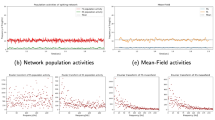Abstract
A mathematical model is presented, based on existing anatomical and physiological data, which simulates the behaviour of representative types of cortical cells. It is used to test whether a set of synaptic connections of these cells exists, which, paced by the same rhythmical thalamic input, could produce spindles under normal conditions and spike and wave discharges (SW) under conditions of cortical hyperexcitability. This is possible if the interneurons do not provide recurrent excitatory or inhibitory input on themselves, if the thalamic afferents contact the cortical projecting pyramidal cells through local excitatory neurons, and if the inhibitory interneurons receive input only from the pyramidal cells. The results suggest that an increase of all cortical synaptic actions (both excitatory and inhibitory) is sufficient for the transition from spindles to the first stages in the development of SW discharges in the cortex, whereas the thalamus can be driven to the SW characteristic frequency at the immediate next stages.
Similar content being viewed by others
References
Avoli, M., Gloor, P., Kostopoulos, G., andNaquet, R. (Eds) (1990): ‘Generalized epilepsy: neurobiological approaches’ (Birkhauser, Boston)
Connors, B. W., andGutnick, M. J. (1990): ‘Intrinsic firing patterns of diverse neocortical neurons’,Trends Neurosci.,13, (3), pp. 99–104
Connors, B. W., Malenka, R. C., andSilva, L. R. (1988): ‘Two inhibitory postsynaptic potentials and GABAA and GABAB receptor-mediated responses in neocortex of rat and cat’,J. Neurophysiol.,406, pp. 443–468
Coulter, D. A., andLee C. J. (1993): ‘Thalamocortical rhythm generation in vitro: extra- and intracellular recordings in mouse thalamocortical slices perfused with low Mg2+ medium’,Brain Res.,631, pp. 137–142
Creutzfeldt, O., andHouchin, J. (1974): ‘Neuronal basis of EEG waves’in Remond, A., andCreutzfeldt, O. (Eds.): ‘Handbook of electroencephalography and clinical neurophysiology’ Vol. 20 (Elsevier, New York) pp. 5–55
Douglas, R. J., andMartin, K. A. C. (1990): ‘Neocortex’in Shepherd, G. M. (Ed.): ‘The Synaptic Organization of the Brain’ (Oxford University Press, New York) pp. 389–438
Fisher, R. S., andPrince, D. A. (1977): ‘Spike-wave rhythms in cat cortex induced by parental penicillin. II. Cellular features’,Electroenceph. Clin. Neurophysiol.,42, pp. 625–639
Gloor, P. (1979): ‘Generalized epilepsy with spike and wave discharges: a reinterpretation of its electrographic and clinical manifestations’,Epilepsia,20, pp. 571–588
Gloor, P., Pelegrini, A., andKostopoulos, G. (1979): ‘Effects of changes in cortical excitability upon the epileptic bursts in generalized penicillin epilepsy of cat’,Electroenceph. Clin. Neurophysiol.,46, pp. 274–289
Gloor, P., andFariello, R. G. (1988): ‘Generalized epilepsy: some of its cellular mechanisms differ from those of focal epilepsy’,Trends Neurosci.,11, pp. 63–68
Gloor, P., Avoli, M., andKostopoulos, G. (1990): ‘Thalamocortical relationships in generalized epilepsy with bilaterally synchronous spike-and-wave discharge’ inAvoli, M.,et al., (Eds.): ‘Generalized epilepsy: neurobiological approaches’, (Birkhauser, Boston) pp. 190–212.
Herkenham, M. (1986): ‘New perspectives on the organization and evolution of nonspecific thalamocortical projections’in Jones et al., (Eds.): ‘Cerebral cortex’, (Plenum Press, New York) pp 403–445
Jasper, H., andDroogleever-Fortuyn, J. (1946): ‘Experimental studies of the functional anatomy of petit mall epilepsy’,Res. Publ. Assoc. Res. Nerv. Ment. Dis.,26, pp. 272–298
Kostopoulos, G., Gloor, P., Pelegrini, A., andGotman, J. (1981): ‘A study of the transition from spindles to spike and wave discharges in feline generalized penicillin epilepsy. Microphysiological features’,Exper. Neurol.,73, pp. 55–77.
Kostopoulos, G. (1982): ‘Potentiation and modification of recruiting responses precedes the appearance of spike and wave discharges in feline generalized penicillin epilepsy’,Electroencephal. Clin. Neurophysiol.,53, pp. 467–478
Kostopoulos, G., andGloor, P. (1982): ‘A mechanism for spike-wave discharge in the feline penicillin epilepsy and its relationship to spindle generation’in Sterman, M. B., Passouant, P., andShouse, N. (Eds.): ‘Sleep and epilepsy’ (Academic Press, New York), pp. 11–27
Kostopoulos, G., Avoli, M., andGloor, P. (1983): ‘Participation of cortical recurrent inhibition in the genesis of spike and wave discharge in feline generalized penicillin epilepsy’,Brain Res.,267, pp. 101–112
Kostopoulos, G., andAntoniadis, G. (1991): ‘A comparison of recurrent inhibition and of paired-pulse facilitation in hippocampal slices from normal and genetically epileptic mice’,Epilepsy Res.,9, (3), pp. 184–194
Kostopoulos, G., andAntoniadis, G. (1992): ‘Active role of cortical inhibition in the development of generalized epilepsy with spike and wave discharges: Evidence from electrophysiological, microiontophoretic and simulation studies’in Avanzini, G., Engel J. Jr., Fariello, R., andHeinemann, U. (Eds.), ‘Neurotransmitter in epilepsy: epilepsy research supplement vol.’ (Elsevier, New York) pp. 125–133
Knowles, D., Traub, R., Wong, R., andMiles, R. (1985): ‘Properties of neural networks: experimentation and modeling of the epileptic hippocampal slice’,Trends Neurosci.,8, (2), pp. 73–79
Lytton, W., andSejnowski, T. (1991): ‘Simulation of cortical pyramidal neurons synchronized by inhibitory interneurons’,J. Neurophysiol.,66, (3), pp. 1059–1079
McCormick, D., Connors, B., Lighthall, J., andPrince, D. (1985): ‘Comparative electrophysiology of pyramidal and sparsely spiny stellate neurons of the neocortex’,J. Neurophysiol.,54, pp. 782–806
McCormick, D., andPrince, D. (1987): ‘Post-natal development of electrophysiological properties of rat cerebral cortical pyramidal neurones’,J. Neurophysiol.,393, pp. 743–762
Nowack, W., andTheodoridis, G. (1991): ‘The thalamocortical contribution to epilepsy’,Bull. Math. Biol.,53, (4), pp. 505–523
Steriade, M., andLlinas, R. (1988): ‘The functional states of the thalamus and the associated neuronal interplay’,Physiological Rev.,68, (3), pp. 649–742
Steriade, M., Dossi, R., andNunez, A. (1991): ‘Network modulation of a slow intrinsic oscillation of cat thalamocortical neurons implicated in sleep delta waves: cortically induced synchronization and brainstem cholinergic suppression’,J. Neurosci.,11, (10), pp. 3200–3217
Sutor, B., andHablitz, J. J. (1989): ‘EPSPs in rat neocortical neurons in vitro. 1. Electrophysiological evidence for two distinct EPSPs’,J. Neurophysiol.,61, (3), pp. 607–624
Walmsley, B., andStuklis, R. (1989): ‘Effects of spatial and temporal dispersion of synaptic input on the time course of synaptic potentials’,J. Neurophysiol.,61, (4), pp. 681–687
White, E. L. (1986): ‘Termination of thalamic afferents in the cerebral cortex’in Jones et al. (Eds.): ‘Cerebral-cortex’, pp. 271–289.
Author information
Authors and Affiliations
Rights and permissions
About this article
Cite this article
Antoniadis, G., Kostopoulos, G. Simulation study for the transition from spindles to spike and wave epileptogenesis. Med. Biol. Eng. Comput. 33, 241–246 (1995). https://doi.org/10.1007/BF02510494
Received:
Accepted:
Issue Date:
DOI: https://doi.org/10.1007/BF02510494




